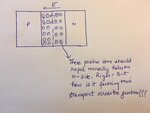Robotduck
Member level 2

With zero bias, due to concentration gradient, the diffusion of majority carriers happen. Because of this we have built in E which favors the flow of minority carriers... on the n side we have uncovered positive ions and these ions oppose the motion of holes from p side but helps the thermally generated holes on the n side to flow across the junction. The thing that I do not follow, these positive ions should repel the minority holes on the n side as well, instead minority carrier holes get swept across the junction.. Same phenomenon on the p side , the minority e should experience a repulsive force from uncovered negative ions on p side but why doesnÂ’t this happen ?:-x



